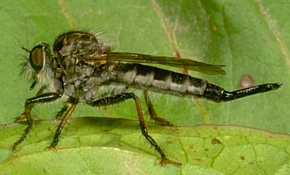

|
FALL
2003 CONTENTS
| |
|
2003 Environmental
Academy |
|
|
This summer, over two-dozen Kentucky science teachers and 4H agents took a Road Trip Across Kentucky to explore our state's tremendous ecosystem diversity. This week-long academy was designed and implemented by some of the finest environmental education experts in the state and took our teachers to Mammoth Cave, the Daniel Boone National Forest, and to several natural areas in between, providing a broad survey of Kentucky's physiographic regions.
|
 An upland forest at Mammoth Cave National Park: one of the habitats investigated during the Road Trip Across Kentucky (B. Newton, 2003) |
|
|
ENTOMOLOGY CONNECTION: On this road trip, teachers investigated changes within and between different habitats by examining a variety of living and non-living environmental factors. They identified trees, rated wildlife habitats, tested soils, and evaluated water quality. And, of course, they examined insect populations. Using the same entomological sampling tools that scientific researchers use (including sweep nets, field guides, sticky traps, and Berlese funnels) teachers on our academy learned about the different insects that live in various Kentucky habitats. |
| It wasn't long
before our academy team members were identifying common insects and predicting
what types would occur in different habitats. More importantly, by
studying insects at the same time that they were learning about trees, wildlife,
soil, and other environmental features, our academy trainees saw the ecology
connections between all of these factors.
The academy was made possible through the combined efforts of the Tracy Farmer Center For The Environment and The University of Kentucky Cooperative Extension Service. If you are an intrepid educator, and want to learn more about the environment, contact us (see contact info below), or Stephanie Jenkins at the Tracy Farmer Center For the Environment at (859) 257-4974 to learn about future training opportunities. |
|
|
ACTIVITY:
FIELD GUIDE TO
SCHOOLYARD INSECTS
|
|
Insect field guides are mentioned quite often in the Wee Beasties newsletter. That's because entomologists use field guides a lot. A whole lot. In fact, most entomologists don't leave the house without a field guide (or two). The truth is, even the most experienced entomologist is always finding insects that he or she has never seen before, and a field guide is essential for quick identification of unusual insects. |
|
|
Insect field guides are also great tools for the classroom. When a student brings in an unusual insect, a field guide can help to determine its identity and learn more about it. As a teacher, though, it might occur to you that there is another way that field guides can be used within a science curriculum. Instead of just reading field guides, have your students make one for the insects that live in your schoolyard, school garden, or any other outdoor area to which you and your students have access. Making a field guide is easy. The first step is to allow your students to search the schoolyard on a warm day. Instruct them to look for insects, and to try and find one that really interests them. From there, your students can try to learn a little about the insect in the classroom and then return outside for more detailed observations. After each student becomes an "expert" on a different insect, they can each be responsible for creating one page in a field guide. If you are interested in having your students work on a field guide, take a look at this detailed activity guide (PDF format) which includes a copyable form that students can fill out for each page of the guide. Feel free to change this activity to suit the needs of your students or curriculum. |
|
CRITTER
OF THE MONTH: ROBBER FLY
|
||
|
Robber flies are some of the most fascinating predators in the insect world. They are called robber flies because they are skilled at "snatching" other insects out of the air. Robber flies are great fliers and have no trouble capturing flies, moths, bees, and other flying insects, some of which are larger than themselves! |
 "Bee Killer" Robber Fly (R. Bessin, 2000) |
|
|
The creature at the top of this newsletter is a robber fly from the Diogmites genus that is very common in agricultural habitats. The robber fly pictured above is the more familiar "bee killer" robber fly, well-known for preying on bumble bees and other large insects. Kentucky is home to these and several other robber fly species. Read more about these insects in the new Robber Flies entry of the Critter Case Files. |
||
| Critter Of The Month is a new Wee Beasties feature. Each month, we will feature one of the critters from the Critter Case Files, University of Kentucky's on-line field guide to insects, spiders, and related critters. | ||
|
||||
| The Entomology Department will
be present with displays, insects, and information at the following events
and locations during the upcoming months:
|
|
|||
| If you have ideas, experiences,
or information that you would like to share or would like information about
educational resources available through the University of Kentucky, Department
of Entomology, write, phone, or email:
Blake Newton View and print Wee Beasties in the Adobe Acrobat (tm) PDF format. The Adobe Acrobat (TM) PDF format allows you to download, view, search, and print, while maintaining the original printed look of the document. You will need the (free) Adobe Acrobat Reader plug-in to read PDF documents.
Black and white images
used with permission from http://www.arttoday.com
|